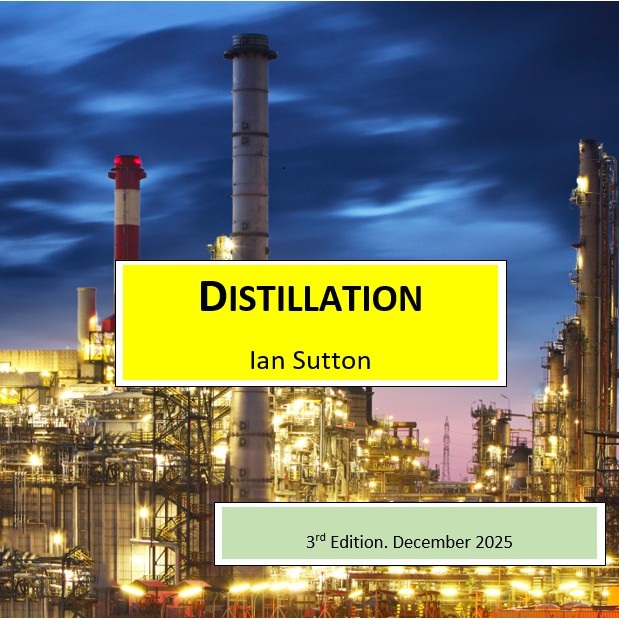Primer: Distillation (3rd Edition)

The Primer Distillation is priced at $25 (U.S.) It can be purchased here. The Kindle link is here.
Distillation
This distillation primer provides a structured introduction to distillation principles, column design, reboilers, reflux systems, and operating practices used in refineries, chemical plants, and batch-processing industries. It is written for engineers, operators, and technical professionals who need a clear overview of industrial distillation methods, equipment, and terminology.
The primer explains the principles and design of both batch and continuous distillation systems, ranging from simple stills to refinery-scale columns. Topics include column internals, reboilers, packing and trays, reflux control, and advanced separation methods such as azeotropic and extractive distillation. Safety, environmental considerations, and economic factors are also addressed, with references to relevant industry standards.
This primer concludes with a 10-question knowledge check, making it suitable for professional development and training.
Author

The author of this Primer is Ian Sutton.
Substack

The matching Substack is here.
The Primer Series
The current list of available primers is available here.
Table of Contents
Introduction
Principles of Distillation
Batch Distillation
Specialty and Fine Chemicals
Pharmaceutical Manufacturing
Solvent Recovery
Research Applications
Continuous Distillation
Feed Composition
Reflux and Reflux Ratio
Close-Boiling Separations
Azeotropic Distillation
Extractive Distillation
Reboilers
Thermosyphon Reboiler
Kettle Reboiler
Forced Circulation Reboiler
Column Internals
Trays (Plates)
Packing
Operations
Startup
Steady-State Operation
Shutdown
Operational Challenges
Economics of Distillation
Safety and Environmental
Standards and Best Practices
Conclusion
Knowledge Check: 10-Question Quiz
Questions
Answer Key
Quiz
1) What is the primary separation principle behind distillation?
a) Difference in density
b) Difference in molecular weight
c) Difference in volatility
d) Difference in solubility
2) In a distillation column, what is the purpose of the reboiler?
a) To cool down the overhead vapor
b) To vaporize the bottom liquid and drive separation
c) To neutralize acid gases
d) To remove dissolved solids
3) What does a reflux ratio of 3.0 mean?
a) 3% of the vapor is returned as reflux
b) Three components are being separated
c) The top temperature is three times the bottom temperature
d) Three units of reflux are returned for every one unit of distillate withdrawn
4) Which type of reboiler uses a pump to circulate liquid through the heat exchanger?
a) Thermosyphon reboiler
b) Forced circulation reboiler
c) Kettle reboiler
d) Bubble-cap reboiler
5) Which of the following is a disadvantage of using trays in a distillation column?
a) Low pressure drop
b) Higher pressure drop than packing
c) Inability to handle large flow rates
d) High risk of vapor leaks
6) What operational problem occurs when vapor flow is too low to hold liquid on trays?
a) Flooding
b) Entrainment
c) Weeping or dumping
d) Foaming
7) Why is batch distillation preferred in pharmaceutical manufacturing?
a) It provides higher throughput
b) It eliminates the need for cleaning
c) It operates continuously without interruption
d) It allows for traceability, cleaning, and flexible product control
8) What is the primary reason for using packing instead of trays in vacuum distillation?
a) Lower pressure drop
b) Higher heat input
c) Increased equipment weight
d) Easier to clean
9) During startup, why is the feed introduced slowly?
a) To reduce operator workload
b) To establish stable liquid and vapor flows
c) To minimize catalyst loss
d) To avoid reflux buildup
10) Which of the following standards governs the mechanical integrity of pressure vessels used in distillation?
a) NFPA 30
b) OSHA 1910.147
c) ASME Section VIII
d) ISA-TR106.00.02
To purchase tis Distillation Primer, please use this link.

